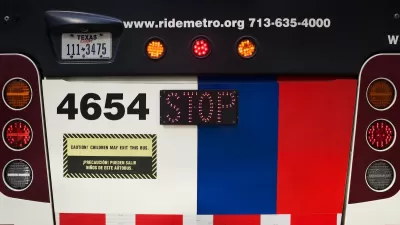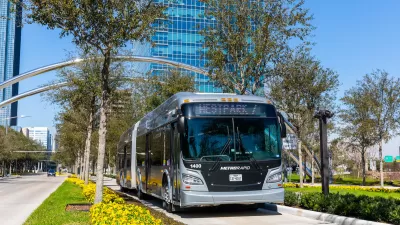When Houston reworked their bus system they emphasized frequency and simplicity. The results have been a bump in ridership, though some complain the system sacrificed coverage and equity to make those gains.

In September of 2015, the Houston METRO bus system reworked their service. A year later, the change is evident. "That massive overhaul decreased the amount of wait times between buses and simplified route geography so maps were easier to understand and read," Bandon Formby reports in the Texas Star Tribune. This change in service gave rise to a 3% increase in ridership. That number may seem modest but becomes more impressive when compared to the many bus systems that are losing ridership around the country.
Still, this emphasis on more regular service comes at a cost. Formby talked to some commuters who were now further from stops. "Tindle said her old route into work downtown stopped near her home. After the overhaul, the closest stop is now half a mile away. And it isn’t covered." These concerns have also been raised in city government. "After presenting its initial plans for its bus overhaul to the public, Houston METRO’s board agreed to increase the budget for local routes by 4 percent, or about $12 million, amid criticism that poor residents in the city’s northeast quadrant were losing too much service," Formby writes.
This overhaul gets at an important if not "sexy" aspect of successful public transportation. While wild ideas grab headlines, practical concerns about regular service are harder to make newsworthy and, consequently, can be the target of cuts.
FULL STORY: Texas transit agencies eye bus changes after ridership jump in Houston

Alabama: Trump Terminates Settlements for Black Communities Harmed By Raw Sewage
Trump deemed the landmark civil rights agreement “illegal DEI and environmental justice policy.”

Planetizen Federal Action Tracker
A weekly monitor of how Trump’s orders and actions are impacting planners and planning in America.

The 120 Year Old Tiny Home Villages That Sheltered San Francisco’s Earthquake Refugees
More than a century ago, San Francisco mobilized to house thousands of residents displaced by the 1906 earthquake. Could their strategy offer a model for the present?

In Both Crashes and Crime, Public Transportation is Far Safer than Driving
Contrary to popular assumptions, public transportation has far lower crash and crime rates than automobile travel. For safer communities, improve and encourage transit travel.

Report: Zoning Reforms Should Complement Nashville’s Ambitious Transit Plan
Without reform, restrictive zoning codes will limit the impact of the city’s planned transit expansion and could exclude some of the residents who depend on transit the most.

Judge Orders Release of Frozen IRA, IIJA Funding
The decision is a victory for environmental groups who charged that freezing funds for critical infrastructure and disaster response programs caused “real and irreparable harm” to communities.
Urban Design for Planners 1: Software Tools
This six-course series explores essential urban design concepts using open source software and equips planners with the tools they need to participate fully in the urban design process.
Planning for Universal Design
Learn the tools for implementing Universal Design in planning regulations.
Clanton & Associates, Inc.
Jessamine County Fiscal Court
Institute for Housing and Urban Development Studies (IHS)
City of Grandview
Harvard GSD Executive Education
Toledo-Lucas County Plan Commissions
Salt Lake City
NYU Wagner Graduate School of Public Service





























